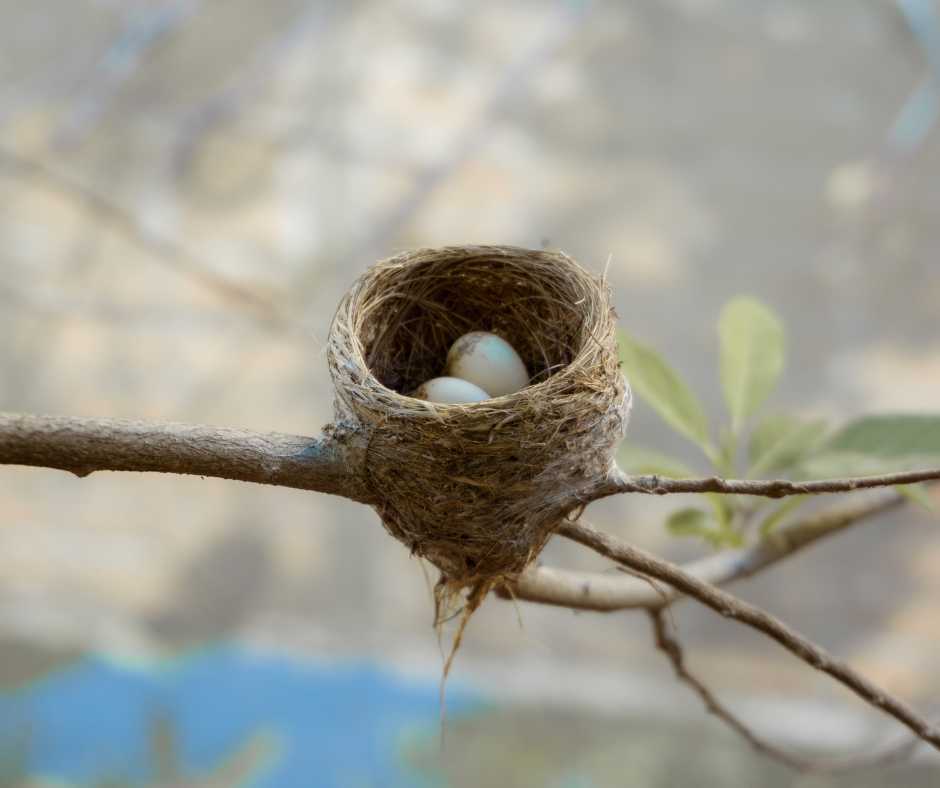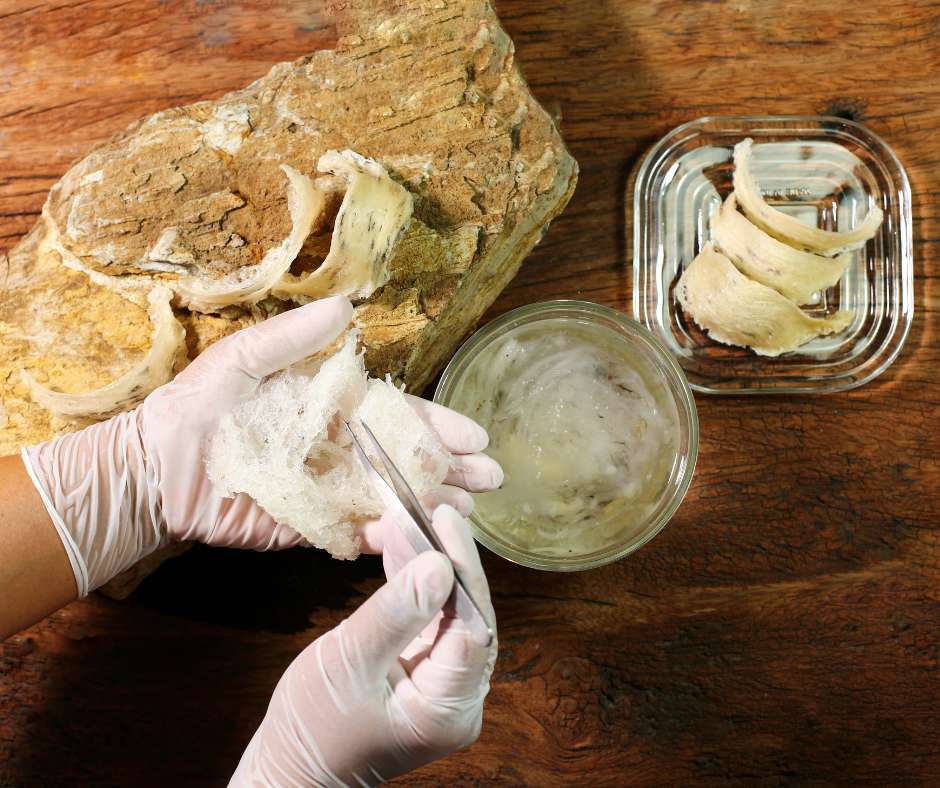Have you ever wondered how to move a bird nest safely? It’s a task that might seem simple but is quite tricky.
If you need to move a bird nest, first make sure it’s okay by checking the laws in your area. If it’s legal, gently push the nest to a safe spot close by, trying to keep it similar to where it was. This helps the birds feel at home and come back.
Whether you’ve discovered a nest in a hazardous spot or are just curious about the process, this blog is your go-to guide.
We’ll explore the essential steps for relocating a nest, whether it contains eggs, babies, or is currently empty.
Learn about the legalities, timing, and careful methods needed to ensure the safety of our feathered friends. Join us as we navigate the delicate world of how to move a bird’s nest.
What is a Bird Nest?
A bird nest is a structure built by avian species to lay eggs and raise their young. Each species designs unique nests, from twig-based homes to intricate mud constructs.
Bird nests are not just structures but nurturing havens for avian species. Each bird builds a unique nest, reflecting its adaptation skills. The variety of bird nests ranges from the simple twig nests made by robins to the complex mud constructions crafted by swallows, each showcasing the marvels of nature.

Why Move a Bird Nest?
Moving a bird’s nest is essential for safety, both for the birds and your home. It’s done to avoid dangers like fan vents or areas with lots of droppings.
Moving a bird nest is a big decision. It’s often needed to keep birds and their eggs safe from hazards like fan vents. It also helps protect our homes from areas that get messy with bird droppings. The goal is to care for the birds while looking after our property, too.
Is It Illegal to Move a Bird’s Nest?
Moving a bird’s nest is often illegal, especially for protected species like migratory birds. Always check local laws and consult experts before acting.
Moving a bird’s nest is only sometimes legal, especially for certain birds like those that travel long distances. Laws differ from place to place. For example, in North America, there are firm rules to protect migratory birds and their homes.
It’s essential to check the laws in your area before you think about moving a nest. If you’re unsure, the best thing to do is to talk to someone who knows a lot about birds, like a wildlife expert. They can give you the right advice so you don’t accidentally break the law or hurt the birds.
You can also read: How to Preserve Wild Bird Eggs
Preparing to Move a Bird Nest
Moving a bird nest is a task that needs careful thought and preparation. It’s a delicate process, and doing it right is vital for the birds and their safety.
Research the Species of Bird and the Original Location
First, find out what type of bird made the nest. Is it a common bird like the house sparrow or a migratory bird that travels a lot? Birds have different ways of nesting, and the time they have babies can be additional, too. Also, think about where the nest is and why that place is notable for the bird family.
Determine When the Nesting Season Is
Knowing the right time to move the nest is really important. If you disturb the birds during their breeding season, they might leave their eggs. It’s crucial to understand when birds like robins have their babies. This helps make sure we keep the nest at a good time for them.
Gather Supplies: Latex Gloves, Blanket or Towel, Box or Container, and Ladder
Getting the right stuff ready is vital. You’ll need latex gloves to keep your hands clean, a soft blanket or towel to gently hold the nest, a strong box or container for moving it, and a ladder if the nest is high up. Remember, being safe and careful is the most important thing when driving a bird’s nest.

Moving the Bird Nest
Now it’s time to actually move the bird nest. This part is crucial, so let’s take it step by step.
Ascending the Ladder Safely
Before you start, make sure the ladder is really steady and safe. Climbing up to the nest safely is essential for both you and the birds. Check the ladder to be sure it won’t wobble or fall.
Finding the Right Spot for the New Nest
Look for a new place for the nest that’s just a short distance from where it was before. You also want to make sure it’s safe from things that could be bad for the nest, like places where there’s a lot of bird poop or other dangers. Think about a spot that’s safe and quiet, where the birds will be happy.
Removing the Old Nest Carefully
Now, carefully pick up the nest. Try to keep it just like it is, without breaking anything. Wear gloves to keep your hands and the nest clean. Be very gentle; remember, this nest is a home for little birds.
Placing the Old Nest in the New Location
Put the nest in its new spot. Try to make it like the old spot as much as you can. Think about things like how much sun it gets and if it’s safe from animals that might bother it. The idea is to make the new spot feel like home for the birds, just like the old one.
How to Move a Bird Nest Without Eggs
If you need to move a bird nest that doesn’t have any eggs, first make sure no birds are using it by watching for a while. When you’re sure it’s empty, carefully move it to a safer spot, being gentle to keep the nest together.
Moving a bird nest without eggs is more straightforward but still requires care. If you see nests made by common species like house sparrows or pigeons, which aren’t protected, and you’re 100% sure other species aren’t using them, you can remove or relocate them properly. (Source: azpigeoncontrolremoval.com)
Ensure the nest is genuinely inactive, with no birds using it. Once confirmed, carefully move it to a safer location. It’s crucial to be gentle and mindful during this process to avoid disturbing any potential nearby active nests.
How to Move a Bird Nest With Eggs
Moving a bird nest that has eggs in it is really tricky. It’s not just about being gentle but also making sure you don’t harm the eggs. It is a big deal because the eggs are very delicate and can be easily hurt.
If you find a nest with eggs that needs to be moved, the best thing to do is call someone who knows a lot about birds, like a bird expert or a professional nest removal service. They have the skills and experience to move the nest safely.
These experts understand how to handle the eggs carefully and can find the best new place for the nest. This way, you can help the birds without putting the eggs at risk.
Remember, when it comes to moving nests with eggs, it’s always better to ask for help from people who know what they’re doing.
How To Move a Bird Nest With Babies
Moving a bird nest that has baby birds in it is a meticulous and sensitive job. These little birds are super delicate, and moving them the wrong way can be dangerous for them. It’s not just about moving the nest; it’s about making sure the baby birds stay safe and healthy.
If you find a nest with baby birds that need moving, the best thing to do is to get in touch with someone who knows a lot about taking care of wild animals, like a wildlife rehabilitator.
These people are trained to handle baby birds and know exactly how to move them safely. Rescue organizations also have a lot of experience with this and can help you.
They will look at the nest and the baby birds and figure out the safest way to move them. This way, you can make sure that the baby birds are taken care of properly during the move.
It’s imperative to remember that when it comes to baby birds, asking for help from experts is the kindest and safest thing to do.
Post-Move Considerations
Once you’ve moved the nest, your job is still ongoing. Now, you need to keep an eye on things to make sure the birds are doing okay in their new home.
Observing Parent Birds’ Activity After Relocating Their Nests
After moving the nest, watch how the parent birds act. Do they come back to the nest? Are they bringing food? These signs will tell you if they like the new spot. If they keep coming back and seem calm, it means they’re okay with the change.
Monitoring Baby Birds’ Development and Safety in Their New Home
It’s also important to watch the baby birds. Are they growing? Do they look healthy and active? Making sure they’re doing well in the new location is critical. If they seem happy and are growing, that’s a good sign that the move was successful.
Keeping an Eye Out for Other Active Nests
Now that you know how to move a nest safely, keep an eye out for other nests that might need help. There may be more nests in your area that are in risky places. With your new skills, you can help more birds stay safe and healthy.
People Also Asked
Can birds find their nest if moved?
Yes, birds can often find their nest if it’s moved a short distance. But it’s best to move it only a little bit so they can find it easily.
Will a bird come back to a disturbed nest?
Sometimes, birds come back to a disturbed nest, but not always. If the nest is slightly disturbed and still safe, they might return. But if it’s moved a lot or damaged, they might not.
How do you stop birds from building a nest?
To stop birds from building a nest, you can gently block the spot they like with things like wire mesh or plastic covers. But remember, it’s essential to be kind and not harm the birds.
How to remove a bird nest without killing them?
To remove a bird’s nest without harming them, wait until the birds have left the nest. Once you’re sure there are no eggs or baby birds, you can carefully take the nest down and move it to a safe spot.
Wrap Up
In wrapping up our guide on how to move a bird nest, remember it’s all about being careful and knowing the rules. Always check if it’s okay to move the nest according to local laws. If you can, move it gently to a safe, close spot.
This way, you help keep the birds safe and happy in their new home. Remember, taking care of nature and its creatures is something we can all do to make a difference!

